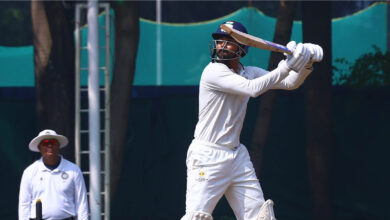In India’s Himalayan win, Sarfaraz Khan tells Shoaib Bashir ‘finish the game, let’s go and see snow on mountain’ | Cricket News

lunch on Day 3, the writing was on the wall. Still miles behind the total that would force India to bat again, half of England’s team was back in the dressing room. A famous win for the home team looked inevitable. Fighting a lost cause with the tail-enders was England’s old hand Joe Root.That was when Sarfaraz Khan, fielding at short-leg, floated a suggestion to England’s young off-spinner Shoaib Bashir. “Jaldi maarke khatam karo, apun pahaad pe baraf dekhne jaate hain (Hit out and finish the game so that we can go to the mountains to see the snow),” he would be heard saying on the stump microphone.
Sarfaraz was speaking for many in the stands, too. Just before tea, England’s resance would end. The innings-and-64-run win in two-and-a-half days gave India a 4-1 series triumph and the fans a weekend to explore the tour destination in the foothills of Himalayas. It was a tame end to a series that had promised to change the status quo of international cricket.
After England’s come-from-behind win in the first Test at Hyderabad in the last week of January, India’s Test domination at home seemed under threat. Back then, England captain Ben Stokes’s ‘Test on steroids’ brand of cricket, that had caught the imagination of the world, looked capable of beating India in India.
But in the next six weeks, India would win four Tests, discover a bunch of 20-something match-winners and show the world that they can win at home on fair pitches playing aggressive and entertaining cricket.
Stokes would concede that they “lost to a better team.” India coach Rahul Dravid did say that they missed key players – read Virat Kohli and Mohammed Shami – but others delivered. “Terrific to see youngsters do well. I am learning from them all the time. Rohit (Sharma) is a terrific leader. The guys gravitate towards him phenomenally, which is fantastic to see,” he said, summing up the series that was much closer than the scoreline suggests.
Playing the long game
The one-sided Dharamsala win was the final confirmation that while England largely played one-dimensional aggressive cricket, India was more rounded, their approach more suited and nuanced to the game’s oldest format.
Taking stock of the top run-getters of the two sides — openers Yashasvi Jaiswal and Zak Crawley — gives an idea about the difference between the two sides.
Jaiswal, 22, with 712 runs, won the Man of the Series award. He also set a new Indian record of hitting 26 sixes in a series. His two double hundreds showed that he was no slogger but knew the art of building an innings. A new-age player who sharpened his big-hitting skills while playing for IPL franchise Rajasthan Royals, he hasn’t forgotten the lessons he learnt on the Mumbai maidans. The boy, who once sold pani-puris near Churchgate railway station to survive in the big city, showed in his first home series the hunger and drive to not just survive, but cement his place at the top of the order.
Compare him to England’s Crawley, 26, who scored 407 runs. Stokes has constantly talked him up, calling him a talented cricketer who will serve England for long. He had four 50s in the five Tests but couldn’t make his starts count. On Saturday here when his team wanted him to stick around, he was out for a duck.
Among the five Indian debutants in the series, Sarfaraz, Dhruv Jurel and Akash Deep showed the temperament to pull their team out of trouble. Clearly, India’s young were more equipped to deal with pressure.
England had a dodgy plan to counter the Indian spinners. Stokes would spell it out at the end of the series. “When India gets on top with the ball, a lot of men come around the bat and you have to find ways to keep those guys out of play and you need to be positive enough to take those risks and sometimes it could lead to downfall,” he would say. It wasn’t sometime, it was most of the time.
England dracted
This was the case on what turned out to be the final day of the series. Jonny Bairstow, playing his 100th Test, would swing his bat like a golf club when Ravichandran Ashwin was weaving his spin-web. He did connect for three sixes and scored 39 runs but when your team has conceded a first-innings lead of 259, a senior player needs to come up with a better game plan.
Before he got out defending to left-arm wr-spinner Kuldeep Yadav, Bairstow was busy arguing with Shubman Gill in the slips. “Why did you tell Jimmy that he should retire?” — the stump mic would relay the out-of-place query to the world. This was in reference to the exchange England veteran James Anderson had with the young Indian batsman on Day 2. England needed Bairstow to battle with the bat.
Commitment was something coach Dravid would point out when asked about the takeaways from the series. “Ashwin coming back to the team after what all he went through for 24 hours. This is what the team is about and the character of the team,” he said referring to the off-spinner’s middle-of-the- Rajkot Test trip to Chennai and back because of his mother’s sudden illness.
Like was the case in the 50-over World Cup, under Rohit Sharma, India in Tests continued to play a delightful style of cricket. Player-of-the-Match Kuldeep Yadav was magical with the ball with former England captain Michael Vaughan comparing him with the ultimate conjurer Shane Warne. That one six that Gill hit at Dharamsala off Anderson with a straight elbow with the Dhauladhar range in the background needs to be framed in oil. Jasprit Bumrah’s toe-crushing yorker to Ollie Pope that saw his middle and leg stumps getting uprooted in Visakhapatnam, too, is in contention for the picture of the series. These were the sights that could inspire kids to play red-ball cricket.
BCCI, in a case of perfect timing, announced that they would earmark Rs 40 crore to incentivise playing Test cricket.
India, in this series, was everything England aspired to be but miserably failed.







